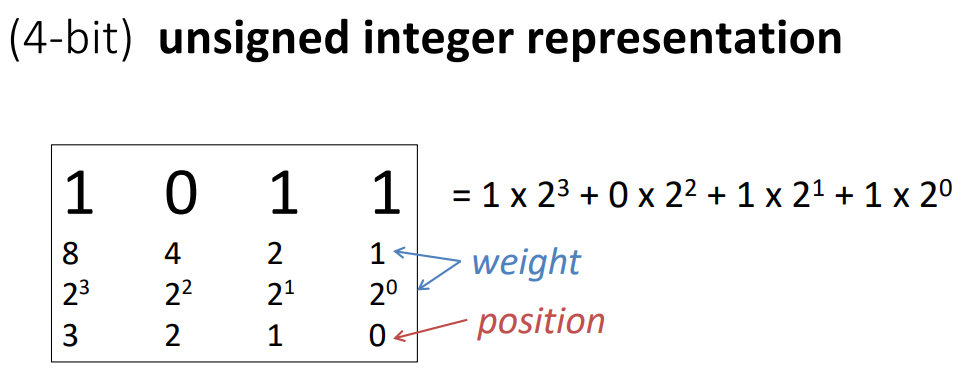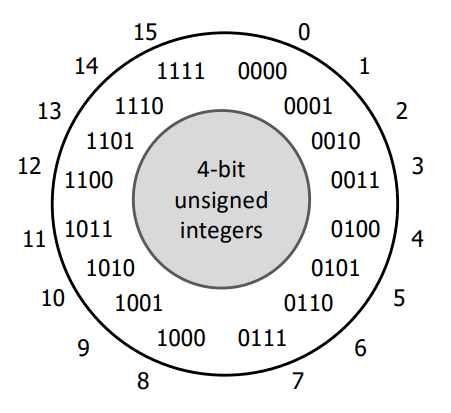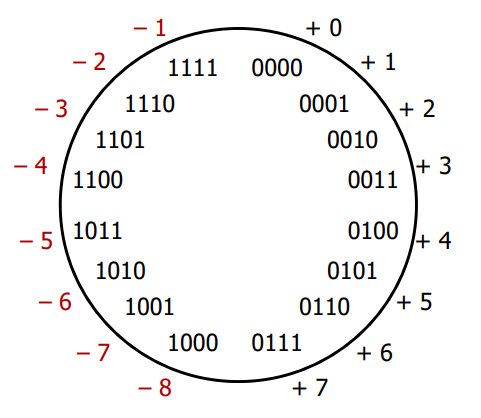CS 208 w20 lecture 3 outline
1 Byte Order
- ok, so we know an
intat0x100consits of the four bytes at0x100,0x101,0x102, and0x103- let's say our
inthas the value0x2ab600b—which byte goes at which address? - this depends on the system we're working on (the system's endianness)
- let's say our
- if the system stores the least significant byte first, we say it is little endian
- used by x86 (i.e., Intel machines), Andriod, iOS
| address | byte |
|---|---|
0x103 |
2a |
0x102 |
b6 |
0x101 |
60 |
0x100 |
0b |
- if the system stores the most significant byte first, we say it is big endian
- used by networks, Oracle, IBM
| address | byte |
|---|---|
0x103 |
0b |
0x102 |
60 |
0x101 |
b6 |
0x100 |
2a |
- POLL: We store the value
0x01020304as a word at address0x100in a big-endian, 64-bit machine- What is the byte of data stored at address
0x104? - four higher-order bytes are
0x00, stored in0x100to0x103, then0x01 02 03 04in0x104to0x107(making the answer0x01)
- What is the byte of data stored at address
- simply a convention or preference, no empirical reason to prefer one over the other
- programmer doesn't need to care in most cases
- it matters when data being sent between machines with different endianness
- will need to keep little-endian ordering in mind once we start working with x86-64 assembly
2 Integer Representation
2.1 Why study this low-level implementation detail?
Because situations where it matters arise in practice and getting it wrong can have very serious consequences
- In 1996 an expensive European Space Agency rocket exploded due to a software crash caused by converting a 64-bit floating point number to a 16-bit signed integer.
- In 2015, it was found that Boeing 787 Dreamliners contained a software flaw, very likely caused by signed integer overflow, that could result in loss of control of the airplane
2.2 bit weight
Consider a bit vector \(x\) of width \(w\) with bits \([x_{w-1},x_{w-2},\ldots,x_0]\). When interpreting \(x\) as an integer, we will refer to the value a particular bit contributes as its weight. Usually, the weight of each bit just corresponds to the value it would have in a binary number (i.e., bit \(x_i\) has a weight of \(2^i\))
2.3 Unsigned Integers
 Count each bit as its positive weight
Count each bit as its positive weight

2.4 Signed Integer Representation as a Design Problem
Consider the two following possibilities for a 4-bit signed integer representation:
- sign and magnitude: the most significant bit indicates positive (0) or negative (1), the other bits count as their weight
0b0011would be 3,0b1011would be -3
- two's complement: the most significant bit counts as its negative weight (-8), the other bits count as their positive weight
0b0011would be 3,0b1101would be -3 (\(-8 + 4 + 1 = -3\))- why "two's complement"? Comes from the fact that \(-n\) is represented as the difference of a power of 2 and \(n\), specifically \(2^w - n\)
- Can see this in
0b1101for -3: \(w = 4\) (4-bit-wide representation), \(2^4 - 3 = 16 - 3 = 13 =\)0b1101
- Can see this in
What are the benefits and downsides to each of these choices? Think about the set of integer values each can represent, how arithmetic might function, how they might translate to unsigned values.
2.4.1 Sign and Magnitude drawbacks
- two representations of zero (
0b0000and0b1000—negative zero??) - arithmetic is cumbersome as negatives "increment" in the wrong direction (i.e., adding 1 to a negative number makes it more negative)

2.4.2 Two's Complement fixes these
- negative numbers "flipped" so that incrementing does what we want
- no more -0
- preserves nice property of sign and magnitude that positive encodings match unsigned encodings
 Note that the most significant bit end up still indicating the sign!
Note that the most significant bit end up still indicating the sign!
2.5 POLL
- Take the 4‐bit number encoding
x = 0b1011 - Which of the following numbers is NOT a valid interpretation of
xusing any of the number representation schemes discussed today? (-4, -5, 11, -3)- Unsigned, Sign and Magnitude, Two’s Complement